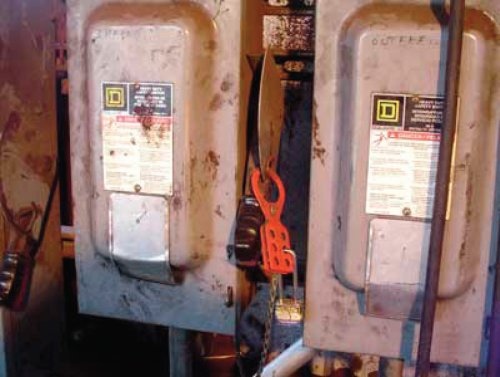


Workers are at risk of severe injury and death during machine maintenance and servicing if proper lockout and tagout procedures are not followed. NIOSH recommends developing and implementing a hazardous energy control program including lockout and tagout procedures and worker training to prevent such incidents.
Machine-related injuries or fatalities can occur during maintenance and servicing tasks when workers are exposed to an uncontrolled release of energy or during unexpected equipment startup. During 1982-2006, NIOSH investigated 185 fatalities related to installation, maintenance, service, or repair tasks on or near machines, equipment, processes, or systems. Investigations were carried out in 20 States as part of the Fatality Assessment and Control Evaluation (FACE) Program. Failure to completely de-energize, block, and/or dissipate the energy source was a factor in 142 (77%) of the incidents; failure to lockout and tagout energy control devices and isolation points after de-energization was a factor in 31 (17%). If machines start up during maintenance, repair, adjusting, or servicing, workers can be caught in the machinery and suffer fractures, crushing injuries, amputations, or death [NIOSH 1999, 2006].
Incidents related to lockout/tagout procedures were the most cited violation in manufacturing by the Occupational Safety and Health Administration (OSHA) during 2006-2007 [Jarrell and Washam 2009]. One study analyzed OSHA accident investigation reports from 1984-1997 and found that in more than half of the 348 investigated cases, lockout procedures were "not even attempted" [Bulzacchelli et al. 2008]. These figures reinforce the necessity of having a written hazardous energy control program and ensuring that employees understand and follow the procedures.
Lockout/tagout procedures APPLY in the following circumstances:
The NIOSH FACE program investigated the following incident in which a millwright was fatally injured because of an uncontrolled release of energy while he was repairing a debarker [NIOSH 2006]:
The teeth on the debarker feed rolls had become worn, and the worker had been assigned to weld additional metal to build up the feed roll teeth. He had not conducted this type of repair before.
To safely de-energize this machine, six electrical sources and one pneumatic energy source needed to be disconnected and locked out, and the pressure in the air line that automatically controls the up and down motion of the feed rolls needed to be bled off. The victim disconnected and locked out two of the electrical sources (See Figure 1), but he did not disconnect and lock out the other four electrical sources or the pneumatic energy source, and he did not bleed off the pressure in the air lines. In this condition, the machine's automatic control system remained energized. As the victim welded metal to the feed roll teeth, he leaned forward and placed his head between the feed rolls to reach areas that required more metal. The feed rolls automatically cycled, and closed over his head.
His supervisor had left to check on another machine and when he returned, he found the millwright caught in the machine. Emergency medical services personnel arrived 20 minutes after receiving the 911 call and attempted cardiopulmonary resuscitation, but the millwright had died.
The millwright had been trained in general lockout/tagout procedures on the job, but the procedures failed to address the following:

Figure 1 - Locks placed on two electrical circuits
The photo above illustrates the south debarker room where locks had been placed on two electrical circuits by the victim [Photo courtesy of SCOSHA].
NIOSH recommends that employers and workers take the following steps to prevent machine-related injuries:
Employers
NIOSH recommends that employers comply with the OSHA regulations outlined in 29 CFR 1910.147, the control of hazardous energy (lockout/tagout). Results of NIOSH fatality investigations indicate that the following steps are particularly important.
Workers
Follow the regulations contained in your employer's hazardous energy control program.
Manufacturers
Consider designing equipment that requires fewer and more easily accessible disconnect points to facilitate the use of safe lockout/tagout procedures for maintenance and repair [NIOSH 2006].
Source: www.cdc.gov/niosh
Title: Workplace Solutions
URL: http://www.deenergize.com/?target=Workplace_Solutions
Printed: Wednesday January 14th, 2026
Copyright © 2026 St. Claire, Inc.
DEenergize is a trademark of St. Claire, Inc.